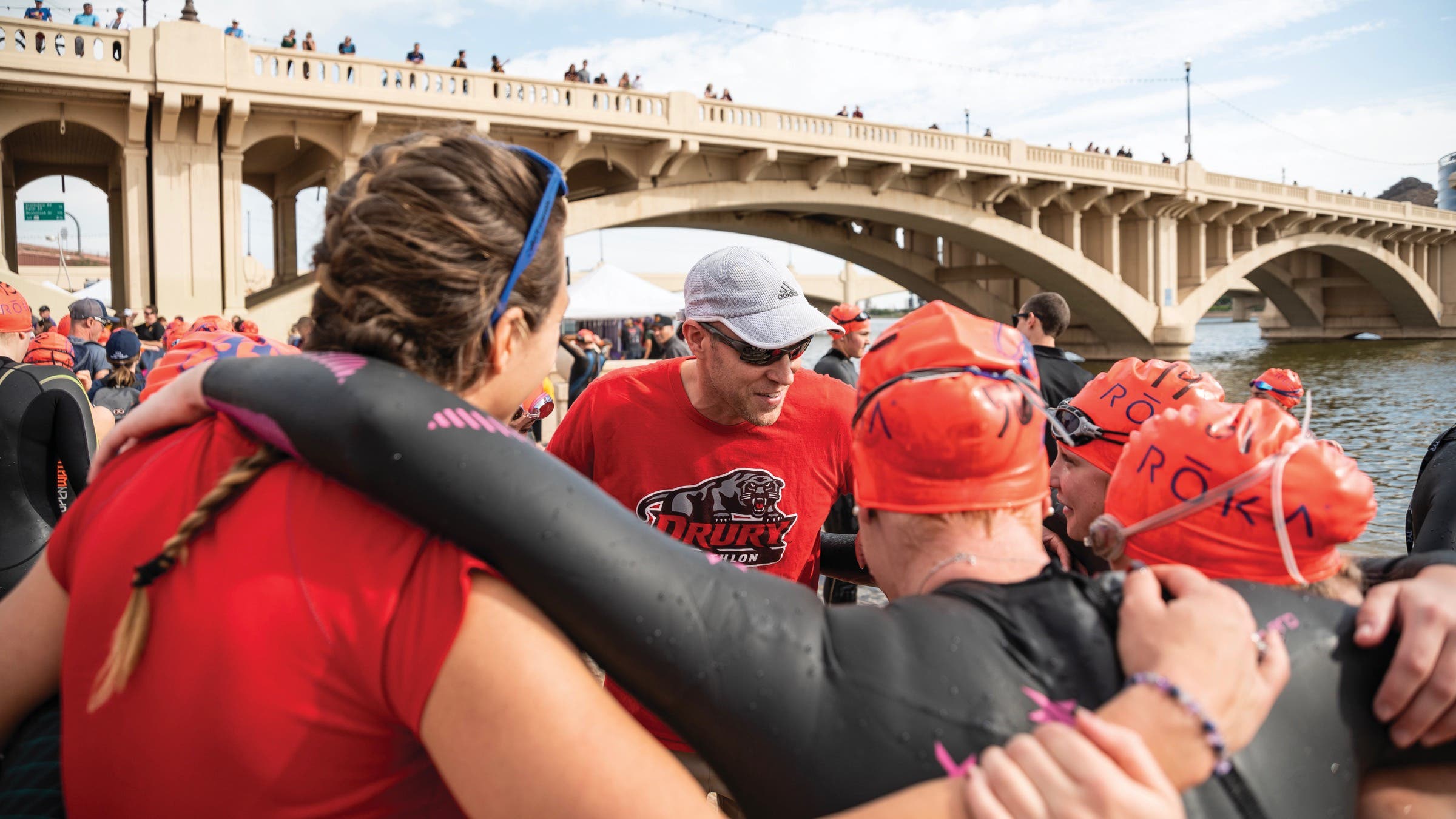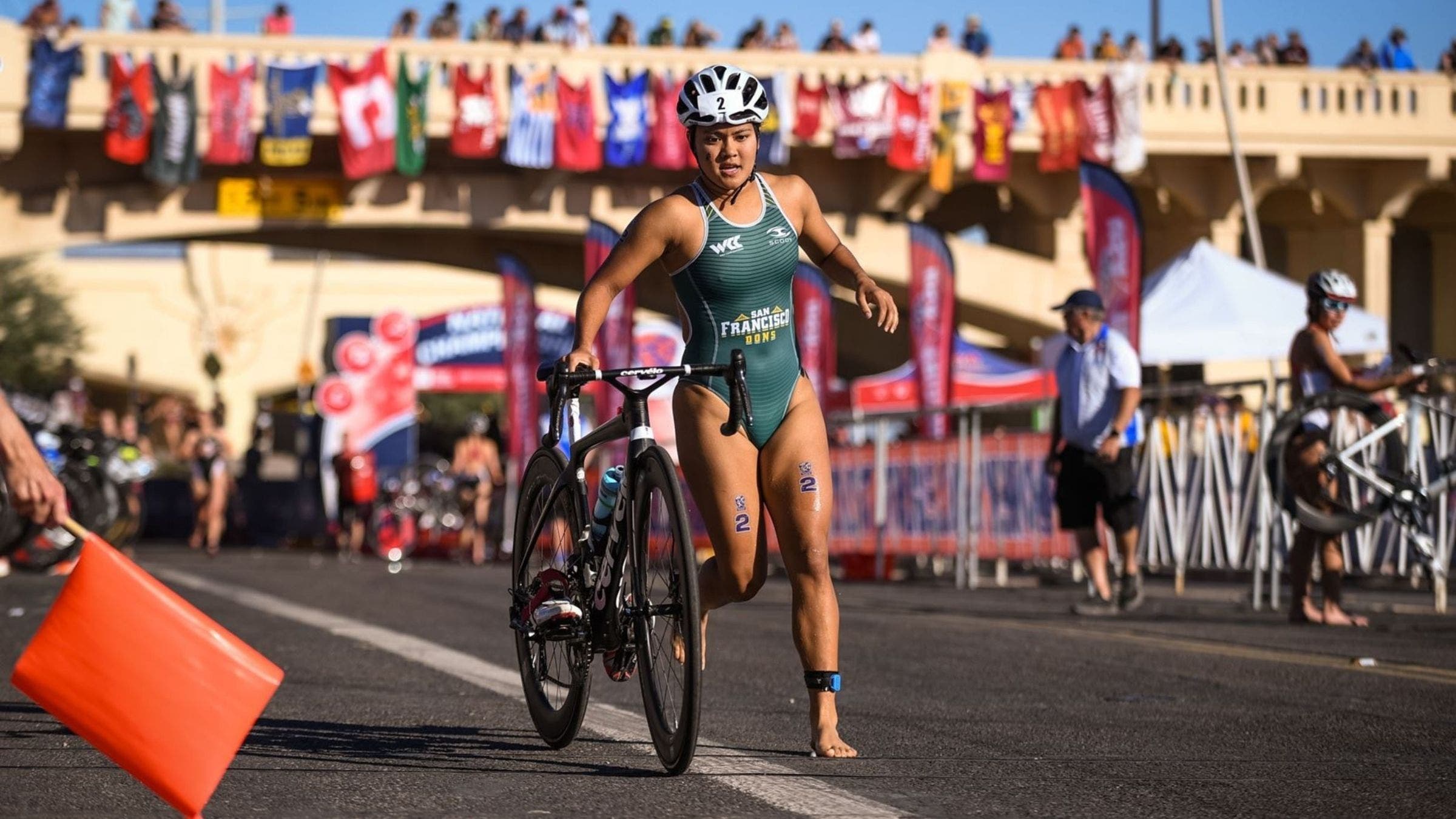Triathlon Hits Mark to Become Next NCAA Sport

(Photo: Nils Nilsen)
USA Triathlon announced today that women’s triathlon has hit a key milestone in the process to becoming the newest NCAA sport: 40 schools have now officially signed on with varsity women’s triathlon teams.
Since women’s triathlon was first approved in 2014 as an NCAA emerging sport for women, a program that creates an easier pathway to NCAA status in an effort to grow women’s sports, USAT has been steadily funding and working towards the deadline of 40 schools by 2024. Now that they’ve hit that criteria, it will trigger a recommendation and eventually a vote to officially add women’s triathlon as an NCAA championship sport. By 2024, you could be watching the NCAA Women’s Triathlon National Championship.
The next steps to NCAA officialdom
For various reasons, the NCAA only counts programs that are up and running (and two of the schools won’t have their programs off-the-ground until next year), so USAT is in the process of getting two more schools through the last steps in their recruitment pipeline too to get the vote moving faster. Once there are officially 40 schools with girls training, racing, and competing, well, it’s still not overnight. “It then is about a two-year process,” said Tim Yount, USAT’s chief sport development officer, who has spearheaded the effort. Triathlon still has to get approved by the committee on women’s athletics, considered by a legislative council, voted on by each of the collegiate divisions, and then have a budget drafted and approved by a different championship committee.
But, the key milestone was to get 40 schools. And with the addition today of California State Polytechnic University, Humboldt triathlon has hit that mark.
“I don’t see any reason why the committee would not approve it,” said Suzette McQueen, the chair of the committee on women’s athletics, when asked last year. She noted the sport’s progress has been good, it does well on campuses, and the communication from USAT has kept the committee in the loop. The only worry Yount has is that there might be concerns that the current programs are too concentrated in the central and eastern regions of the country. But he’s optimistic about the overall progress and potential they’ve shown.
“Yes, I expect it to be approved,” he said.
By 2024, then, triathlon could be the newest NCAA sport. And, then, he really thinks it will grow.

Floodgates open?
“The effect is going to be massive,” Yount said. “I do think it’s going to explode.”
One of the challenges, to date has been the difficulty of growing a sport that isn’t yet a fully approved NCAA championship sport. What that means on a practical level is that the national championship event was run by USAT and wasn’t funded by the NCAA, each school’s scholarships and budget didn’t count towards Title IX requirements yet, and many coaches have noted recruitment was difficult when there isn’t a database of high school triathletes or, more importantly, single sport athletes who could cross over. This why USAT has put $3.5 million into grants to help these programs get off the ground, and the Ironman Foundation kicked in $25,000 for the 40th school—but those schools will ultimately have to flesh out their own sustainable budget models for the long-term.
As the collegiate varsity sport has grown over the last eight years, there have also been notable growing pains and differences between the DI and DIII programs. For years, Arizona State University appeared to be the only large DI funding a massive budget, and this past year was the first time ASU finally seemed to have real competition, with Kira Gupta-Baltazar from San Francisco State winning the national title.
Now that triathlon’s hitting 40 schools, though, and is actually on its way to NCAA officialdom, Yount said he’s hearing from all the big DI programs who have been waiting for the sport to be rubber stamped. Of the 450 schools he’s talked to in the last eight years, he said, 70% of the DI schools wanted to wait until the sport was on its way to approval. The addition of Texas Christian University in the the Power 5 conference last year was big—but now expect to see more SEC, Pac12, and big conference schools come onboard, he said.
For budget, logistics, and Olympic pipeline reasons, the NCAA version of triathlon is a draft-legal sprint—while the more laidback collegiate club scene has traditionally been open to all comers and raced over the non-drafting Olympic distance (with sprint and draft-legal options). And NCAA triathlon will remain women’s only for the foreseeable future—although there are a couple varsity men’s programs who compete in the collegiate club circuit.
But, still, adding a new sport to the NCAA roster—if all the t’s can be crossed and i’s dotted—will inevitably bring money and attention to triathlon, Yount said.
“For every triathlete who’s out there now, they’re going to say, ‘Man, if NCAA triathlon had been around when I was there!'”
RELATED: Is Triathlon Ready for the NCAA?

The Current 40 Collegiate Varsity Triathlon Programs
NCAA DI
Arizona State University (Tempe, Ariz.)
Delaware State University (Dover, Del.)
East Tennessee State University (Johnson City, Tenn.)
Hampton University (Hampton, Va.)
Texas Christian University (Fort Worth, Texas)
University of Denver (Denver, Colo.)
University of San Francisco (San Francisco. Calif.)
University of South Dakota (Vermillion, S.D.)
Wagner College (Staten Island, N.Y.)
NCAA DII
American International College (Springfield, Mass.)
Belmont Abbey College (Belmont, N.C.)
Black Hills State University (Spearfish, S.D.)
California State Polytechnic University, Humboldt (Arcata, Calif.)
Colorado Mesa University (Grand Junction, Colo.)
Daemen College (Amherst, N.Y.)
Davis & Elkins College (Elkins, W.V.)
Drury University (Springfield, Mo.)
Emmanuel College (Franklin Springs, Ga.)
King University (Bristol, Tenn.)
Lake Superior State University (Sault Ste. Marie, Mich.)
Lenoir-Rhyne University (Hickory, N.C.)
Montana State University Billings (Billings, Mont.)
Newberry College (Newberry, S.C.)
Queens University of Charlotte (Charlotte, N.C.)
St. Thomas Aquinas College (Sparkill, N.Y.)
Wingate University (Wingate, N.C.)
NCAA DIII
Alvernia University (Reading, Pa.)
Calvin College (Grand Rapids, Mich.)
Central College (Pella, Iowa)
Coe College (Cedar Rapids, Iowa)
Concordia University Wisconsin (Mequon, Wis.)
Eastern Mennonite University (Harrisonburg, Va.)
Greensboro College (Greensboro, N.C.)
Guilford College (Greensboro, N.C.)
Millikin University (Decatur, Ill.)
North Central College (Naperville, Ill.)
Northern Vermont University-Johnson (Johnson, Vt.)
Transylvania University (Lexington, Ky.)
Trine University (Angola, Ind.)
Willamette University (Salem, Ore.)